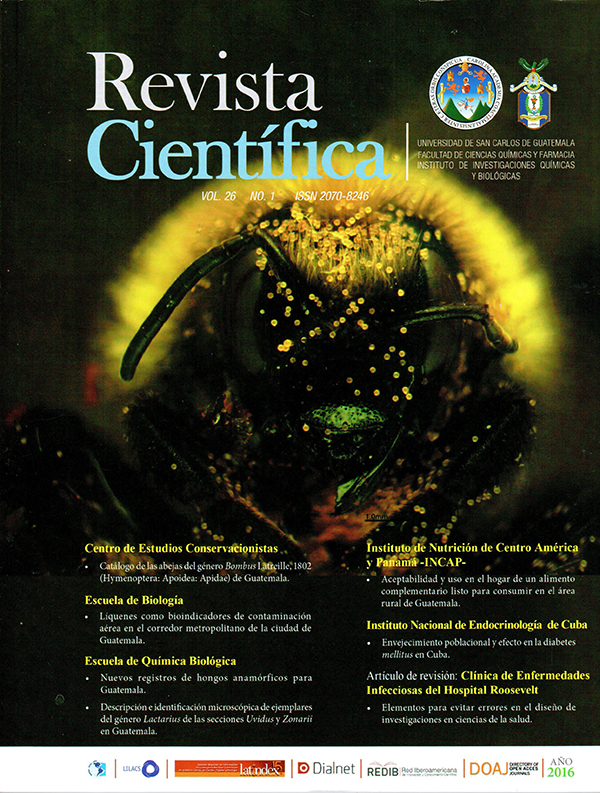Population ageing and effect on diabetes mellitus in Cuba
DOI:
https://doi.org/10.54495/Rev.Cientifica.v26i1.83Keywords:
Demographic transition, population dynamics, incidence, prevalence, mortalityAbstract
Population ageing marks the status of Cuban population, influencing in a particular form on noncommunicable diseases, specifically diabetes mellitus (DM). The incidence of this disease is high, which has been combined since many years ago to the structure of diseases and incidence indicators of noncommunicable ones. Therefore it is possible to think about a relationship between both factors. The objective of this article is to describe the situation of population with diabetes from a demographical and epidemiological perspective. The research is classified as a descriptive study based on annual reports with statistical information of public health indicators of the country from 2000 to 2013, and also publications and national researches related to the population and diabetes mellitus disease. According to it, the following results were found: in the country, demographical evolution has strongly determined. On the other hand, epidemiological analysis shows the reduction of transmissible diseases and an increase of noncommunicable ones, especially DM. The indicators behavior of DM Type 1 and 2 reflects a great relationship with population evolution. It is also observed an increase of death rate despite the multiple health activities done. As a conclusion it can be said that the population ageing has its impact on DM structure, which is going to cause significant effects on the health services provision.
Downloads
References
Alfonso JC. (2006) El descenso de la fecundidad en Cuba: de la Primera a la segunda transición demográfica. Revista Cubana Salud Pública. 32(1). 12-21
Álvarez Vázquez, L., & Martínez, M.T. (2000), Anticoncepción y aborto en Cuba, en E.A. Pantelides, & S. Bott (Eds.), Reproducción, salud y sexualidad en América Latina,Buenos Aires, Editorial Biblos, pp.73-98.
Álvarez, L., & González, V. (2005) Percepciones y comportamientos en adolescentes: Una perspectiva de la salud reproductiva por género. La Habana, Editorial MINSAP.
Alonso, P., Sansó, F.J., Díaz-Canel, A.M., Carrasco, M., & Oliva, T. 2007. Envejecimiento poblacional y fragilidad en el adulto mayor. Revista Cubana Salud Pública, 33(1),11-17. https://doi.org/10.1590/S0864-34662007000100010 DOI: https://doi.org/10.1590/S0864-34662007000100010
Arnold, Y. (2013) Vigilancia epidemiológica en diabetes mellitus 2012. Presentación: Comisión Nacional Técnica Asesora de Diabetes mellitus, La Habana, marzo.
Arnold, Y., Licea, M., Castelo, L., Pagan, P., & Iglesias, I. (2013) Mortalidad por causa básica de diabetes mellitus en Cuba, 2000-2009. Revista peruana de epidemiologia 2013, 17(1).
Dirección Nacional de Registros Médicos y Estadísticas de Salud (2012). Anuario Estadístico de Salud Pública 2011. La Habana. Recuperado de http://www.sld.cu/servicios/estadistica/Dirección Nacional de Registros Médicos y Estadísticas de Salud (2014). Anuarios Estadísticos de Salud Pública 2013 (1ra. Ed.), La Habana, Author.
Gran M.A., & López, L.M. (2003) El descenso de la natalidad en cuba. Revista Cubana Salud Pública, 29 (2), 132-138.
International Diabetes Federation (IDF) (2013). The IDF Diabetes Atlas. (6th. Ed). IDF. Washington DC. 14-109
Programa de las Naciones Unidas para el Desarrollo (2013). Informe sobre Desarrollo Humano. Recuperado de http://www.undp.org/content/dam/venezuela/docs/undp_ve_IDH_2013.pdf
Resolución de la primera conferencia nacional acerca de los objetivos de trabajo del partido. (2012, enero).Diario Granma. Recuperado de http://www.granma.cu/granmad/2012/01/30/nacional/artc08.html.
Rojas Ochoa, F. (2011) Políticas sociales y salud de la población. Revista Cubana de Salud Pública, 37 (4), 362-365. https://doi.org/10.1590/S0864-34662011000400001 DOI: https://doi.org/10.1590/S0864-34662011000400001
Global Action Plan For the prevention and control of noncommunicable diseases 2013-2020 Recuperado de http://apps.who.int/iris/bitstream/10665/94384/1/9789241506236_eng.pdf
Downloads
Published
How to Cite
Issue
Section
License
Copyright (c) 2016 Luisa Álvarez-Vázquez, Yuri Arnold-Domínguez

This work is licensed under a Creative Commons Attribution 4.0 International License.
Authors who publish with this journal agree to the following terms:
- Authors retain copyright and grant the journal right of first publication with the work simultaneously licensed under a Creative Commons Attribution License 4.0 that allows others to share the work with an acknowledgement of the work's authorship and initial publication in this journal.
- Authors are able to enter into separate, additional contractual arrangements for the non-exclusive distribution of the journal's published version of the work (e.g., post it to an institutional repository or publish it in a book), with an acknowledgement of its initial publication in this journal.
- Authors are permitted and encouraged to post their work online (e.g., in institutional repositories or on their website) prior to and during the submission process, as it can lead to productive exchanges, as well as earlier and greater citation of published work.









